Dia de los Reyes
Fourth of January last I saw a Facebook post from This Guy I Know, saying that Pancho Claus was going to spend the Sixth of January with some of his homies and a few Kingly types hitting several of the Mambo’s restaurants in the area to celebrate the day with Pancho’s usual assortment of friends and fans. Well, TGIN is in a position to know these things, and since I’ve been a fan of the Barrio Rabblerouser for a while now, I decided to join the party and grab a few shots. Pancho’s many things, but he’s not a cowboy – which makes him fair game for The Other Texas.
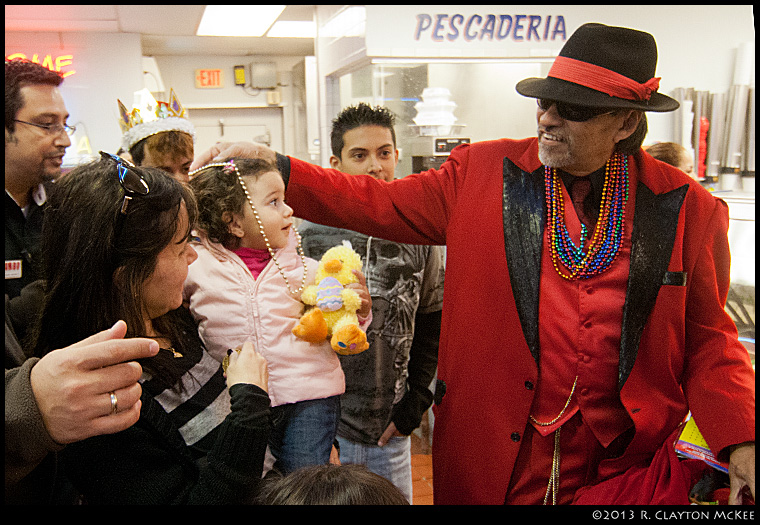
Pancho Claus adorns a new friend.
There’s a Mambo’s near me, and Pancho’s scheduled visit fit pretty well into my agenda for the day. I got there just a few minutes ahead of the entourage. The restaurant, as usual for a weekend, was packed. And then came Pancho and Los Tres Reyes, and it just got crazier.
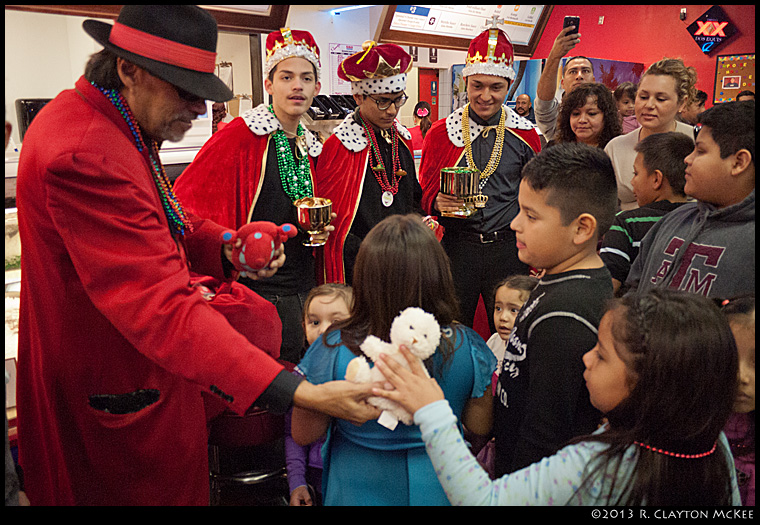
Pancho Claus and friends. And friends. And more friends.
When Pancho’s bag and the Reyes’ cups opened up, there were toys and trinkets and goodies for all the littles…
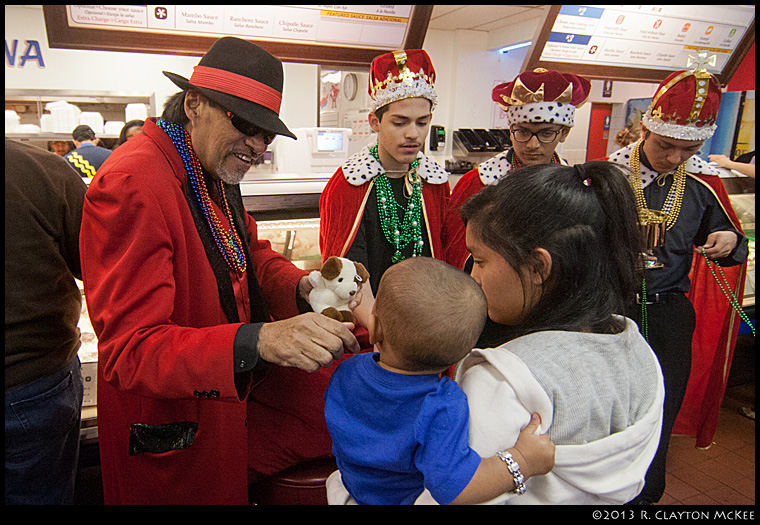
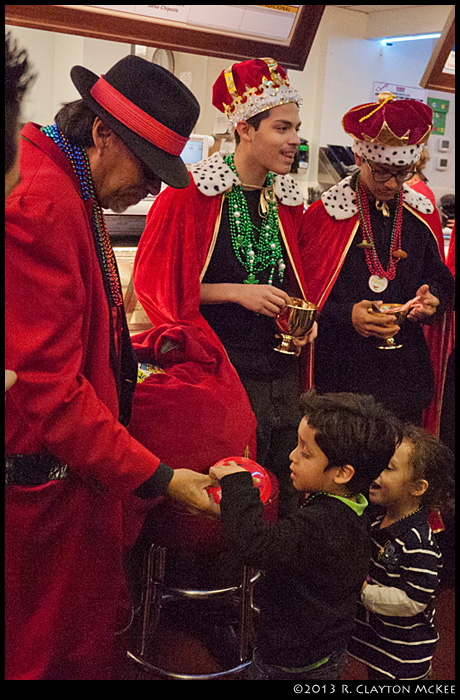
And of course there were pictures to be made…
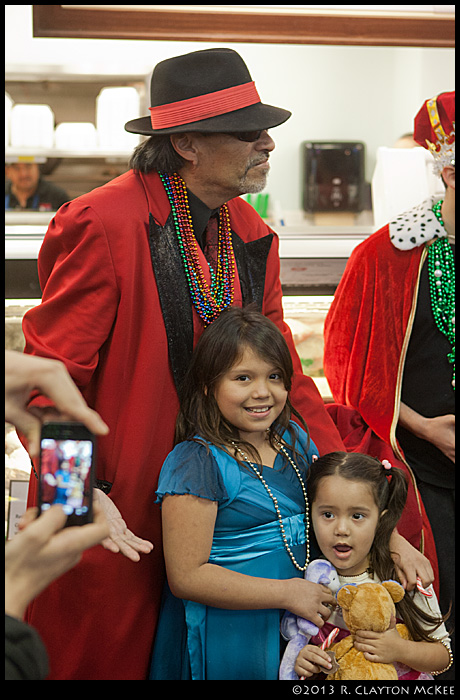
Too quickly, then, they’re off to the next restaurant, way across town, and I’m on to the next gig.
The next morning I got a message from Pancho, with some background on the day, clipped from MexOnline.com. I already knew some of the history and customs (seven years of Sra. Bagby’s Spanish class didn’t go completely to waste), but I had forgotten the finer points, so the refresher was most welcome, and posting a few pix and a small explanation seemed a good idea. (This is not leading into a seventeen-gajillion-frame gallery, I promise. You’ve already seen about all the visuals you’re going to. It’s words from here on.)
In the process of kicking the story around with friends (who don’t necessarily realize that they’re also my first-order lab rats), I discovered that most of them are even more unaware of the religious and cultural customs of Texas’ modern immigrant communities than I am. And me? Well, aside from a few things I’ve picked up in my rapidly disappearing day job, I’m so ignorant it should by rights be painful. But … now I have this wonderful excuse to go be curious and nosy and shoot pictures and ask questions and write about it. “I’ve got a magazine to get out, you know.”
Therefore, this is the inaugural piece in a semi-regular TOT department I’m calling “Other Worlds, Other Ways” in which I/we can explore some of the cultures and customs of the people and groups who have come from elsewhere to Texas and brought some of Home with them.
So that’s the background, mostly.
For whatever it may be worth, I was raised Episcopalian. In that most Anglo-American sect, the 12th Day of Christmas is Epiphany, the day the Three Wise Men arrived in Bethlehem to find the Christ Child in his manger. It was at best a minor holiday, usually noted in our house as the day the Christmas Tree came down (assuming it hadn’t dried out enough to be a fire hazard earlier) and all the Christmas decorations went back into the boxes in the attic for another 11 months or so.
But… Other Worlds, Other Ways.
In Mexico, and in Latin cultures generally, January 6 is El Día de los Tres Reyes, the Day of the Three Kings. According to Matthew, the Three Kings brought presents for the Christ child, and so this is also the traditional day for the spoiling of the young.
Dia de los Reyes is the finale of the Christmas Season proper, though celebrations continue at a diminished pace for another couple of months.
The “official” celebration sometimes begins a few days earlier, when children write letters to the Magi, explaining clearly what good children they’ve been for the past year and requesting appropriate rewards. These letters are then transported magically (helium balloons appear to be involved as well) to the appropriate recipients for fulfillment.
On the fifth of January, there are grand parades as the Magi and their retinues arrive in the town square – all over the world on the same night.
After the parade there are sometimes fireworks and of course speeches and such, and then it’s time to take the younglings home.
Private celebrations vary, of course, but generally, treats are left for the camels, drinks (milk, water, or anise) are left for the Magi, the Magi themselves are added to the family Nativity, and shoes are carefully arranged to be found easily by Magi bearing gifts. Then children head to bed – where they may actually sleep for a while.
The next morning, as children will do, they pop awake (perhaps more early than their parents might wish) and stampede to their shoes to find that the Magi have, of course, come and gone, leaving gifts and goodies. (I’m told that only very rarely do they actually leave coal.)
At some point in the celebration, sometimes the night before and sometimes the morning after, comes the traditional “Rosca de Reyes” (Kings’ Cake), served with tamales and hot chocolate.
There’s a great deal of symbolism (and a tiny figurine) baked into the cake. The cake itself is in the shape of a crown. The figurine, a representation of the infant Jesus, is hidden to remind celebrants that the Christ child had to be hidden at birth so that Herod’s men would not find Him, as they would certainly have killed Him and ruined the entire story. The cake itself is a fairly heavy sweetbread, topped with candied fruit and sometimes sweet cream or filling.
The person who finds the figurine in his or her slice is responsible for the tamales, and sometimes the entire Fiesta, on February 2. (Candlemas, the presentation of the baby Jesus at the temple.)
And the rest of the day is given over to family and friends and all that togetherness stuff.
———
Sources:
Dia de Reyes, the story of Los Tres Reyes Magos
(suggested by Pancho Claus)
Paloma Corredor: Latino Christmas isn’t over until el Dia de los Reyes Magos
(suggested by Lilibeth Andre)
Ya Vienen Los Reyes Magos!
The Three Wise Men Are Coming!
(suggested by DuckDuckGo)
